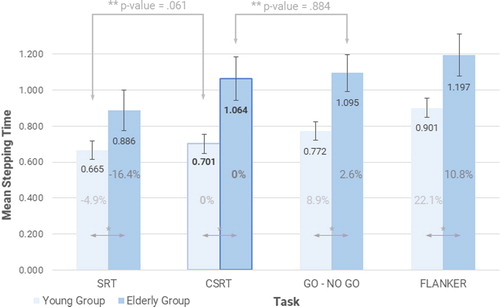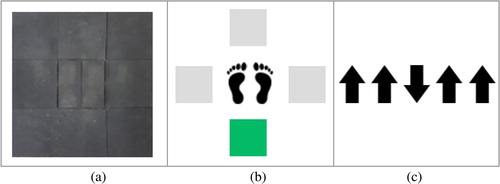1. Introduction
Falls and fall-related injuries correspond to major, public health problems, especially among the elderly (Tinetti Citation2003). These injuries are a considerable burden on public health-care budgets in many western countries increasing every year due to ageing population (Heinrich et al. Citation2010).
In order to avoid a fall, it requires perception of a postural threat, selection of an appropriate corrective response, and proper response execution. The individual physiological components required to avoid falls—sensory acuity, reaction time, and reactive stepping—have been previously investigated.
The choice stepping reaction time test (CSRT) is an integrated test that is a good indicator of the risk of fall and has correlation with impaired cognitive functions (Lord and Fitzpatrick Citation2001). However, its integrated aspect does not allow to get insight into the specific deficits to precisely define the subjects profile with risk of fall (Pijnappels et al. Citation2010).
Therefore, the aim of this work was to complement the CSRT with additional tasks to better assess in elderly people perception and response execution, attention and inhibition capacity. For this purpose, a test with different tasks is proposed. It was tested in two different samples, young and elderly, in order to determinate differences between them and anticipate relevant conclusions.
2. Methods
2.1. Participants
A test, which consists of four different tasks to measure stepping time (ST: time from the appearance of a stimulus until step on a target), has been conducted on two samples of healthy subjects (they could walk without external help and exercised at least 30 min/day). Prior the test, subjects signed a form, consenting to undergo and understand the tests. The research was approved by Univ. Eiffel’s ethical committee and complied the ethical standards of the Declaration of Helsinki. Young group (YG), consisted on eleven young subjects 7 males and 4 females (age 24.91 ± 2.77 y.; height 173.55 ± 9.55 cm; dominant hand side: 10 R, 1 L; dominant leg side: 8 R, 3 L). Elderly group (EG), consisted on nine elderly subjects 3 males and 6 females (age 79.89 ± 3.37 y.; height 163.67 ± 8.65 cm; dominant hand side: 8 R, 1 L; dominant leg side: 6 R, 3 L).
2.2. Instrumentation
The device used was a multimodal force platform of postural analysis, which was designed and manufactured in the LISSI (). It comprises six low cost pressure sensors, made with a plastic sheet whose electrical resistance varies with pressure. There are four stepped-on areas as targets in the following directions: forward (F), backward (B), rightward (R) and leftward (L); the feet are placed in the remaining two areas where it is detected whether a foot has been lifted. Pressure changes are read by an Arduino (programmed in C language), which measures the ST and the pressure. The graphical interface, which manages the stimulus display, the data recorded, and task implementation are programmed in Java. A repeatability study was carried out (Klotz Citation2019) between our device and a gold-standard force platform, with ST bias of 26 ms.
2.3. Experimental procedure
The four tasks have been designed based on the literature (Lord and Fitzpatrick Citation2001; Yechiam et al. Citation2006; Davranche et al. Citation2009). In all tasks the subject was required to step as quickly as possible on a designated target, without anticipating stimulus appearance. The step foot is a decision of the subject (except in R and L, which had to be with the corresponding leg). Subjects performed the test barefoot. A training trial before each task was carried out, which consisted of one repetition per direction and condition. The task consisted on four repetitions per direction and condition, which were the following:
Simple Reaction Time (SRT): the subject was aware of the target direction to be stepped on. Three trials in each direction were performed one after the other, with the following order: F, B, lateral (depends on the dominant leg). Each direction is represented on screen by an empty square in that direction, and the stimuli were displayed in them as a green signal (). This test primarily assesses the perception and response execution capacities.
Choice Stepping Reaction Time (CSRT): similar task to SRT, but the targets were randomized (subjects were not aware of the target to be stepped on). CRST requires additional resources than the SRT, including attention and decisional processes essentially.
Go/No Go: new stimulus introduced in this task, which is a red signal that indicates not to move. Directions and stimulus type are randomized. This task is more complex than the CSRT (two information – direction and colour of the target – have to be perceived and processed) and emphasized inhibitory control.
Flanker (FL): this task introduces congruent and non-congruent stimuli. It has a different display: colour signals are changed by five arrows displayed in the central part of the screen (). The central arrow indicates the target, while the side arrows are used to present a congruent or non-congruent information (if they are in the same or in a different direction as the central arrow). Directions and stimulus type (congruent/non-congruent) are randomized. It mainly assesses selective attention and perceptual inhibition.
2.4. Data analysis
A descriptive analysis (mean and SD) of ST for each task and group (YG and EG) has been carried out. Outliers have been removed and not considered in the analysis. A one way repeated-measure analysis of variance (RMAnova) on ST with factor task was carried out, as well as Tukey paired comparison between tasks of each group. Possible differences between groups, for the same task, have been analysed individually using a t-test.
3. Results and discussion
Descriptive and statistical analysis results for YG and EG are shown in .
Figure 2. Descriptive and statistical analysis. *Significant differences in t-test between groups. **Tasks pooled by Tukey paired comparison. % Variation in percent. per task with respect to CSRT.

As expected, EG shows significantly higher ST values than YG in all tasks, due to decline in cognitive and functional capacities with age. Likewise, both groups show higher ST values as the difficulty of the tasks increases (Lord and Fitzpatrick Citation2001). RMAnova, for both groups, shows significant differences in a ST collective comparison.
As expected, YG and EG were very well discriminated by the CSRT. Interestingly, about 2/3 of the ST difference in CSRT could be explained by differences in the SRT, i.e., by the capacity to step slowly on a target due to a motor slowdown due to the decrease in muscle mass. Nevertheless, the remaining can be attributed to decreased cognitive capacities in EG (Lord and Fitzpatrick Citation2001).
Go/No Go task includes only minor differences in ST for both YG and EG. In EG, this difference was even non-significant in comparison with CSRT (p-value = .884). In addition, no mistakes have been recorded in both groups. It indicates that the task difficulty should be increased to make it more relevant (e.g., increasing the proportion of No Go trials).
Comparison between congruent and no-congruent conditions has been carried out resulting in significant differences in both groups. However, mean differences between types of stimuli are similar in both groups, which indicates that FL is not especially sensitive comparing EG with YG. In other words, it seems that selective attention is not specifically affected in this particular group of EG.
4. Conclusions
Results confirmed that CSRT is very discriminant for EG and YG and seems particularly relevant to assess the risk of fall. However, it also showed that SRT test add relevant information about the capacity to perform a quick step. It seems a relevant addition to the CSRT to better assess the risk of fall and highlights specific deficiencies. The additional tasks proposed, in the way they were designed, did not bring much to the CSRT or the SRT. However, tracks to improve these tasks have been proposed and should be studied in future studies. The perspective would consist in comparing results from this test to the clinical state of the subjects, with a prospective follow-up of potential falls. Thus, the final goal would be to obtain a test that could complement clinical data resulting in a reliable indicator of risk of fall in elderly to carry out preventive actions improving medical decision-making.
Disclosure statement
No potential conflict of interest was reported by the authors.
Additional information
Funding
References
- Davranche K, Hall B, McMorris T. 2009. Effect of exercise on cognitive control during Eriksen flanker task. J Sport Exerc Psychol. 31(5):628–639.
- Heinrich S, Rapp K, Rissmann U, Becker C, König H. 2010. Cost of falls in old age: a systematic review. Osteoporos Int. 21(6):891–902.
- Klotz S. 2019. Tapis Equilibre. Master mention mecanique - Parcours biomecanique.
- Lord SR, Fitzpatrick RC. 2001. Choice stepping reaction time: a composite measure of falls risk in older people. J Gerontol Series. 56(10):627–632.
- Pijnappels M, Delbaere K, Sturnieks D, Lord SR. 2010. The association between choice stepping reaction time and falls in older adults. Age Ageing. 39(1):99–104.
- Tinetti ME. 2003. Clinical practice. Preventing falls in elderly persons. N Engl J Med. 348(1):42–49.
- Yechiam E, Goodnight J, Bates JE, Busemeyer JR, Dodge KA, Pettit G, Newman JP. 2006. A formal cognitive model of the go/no-go discrimination task: Evaluation and implications. Psychol Assess. 18(3):239–249.

